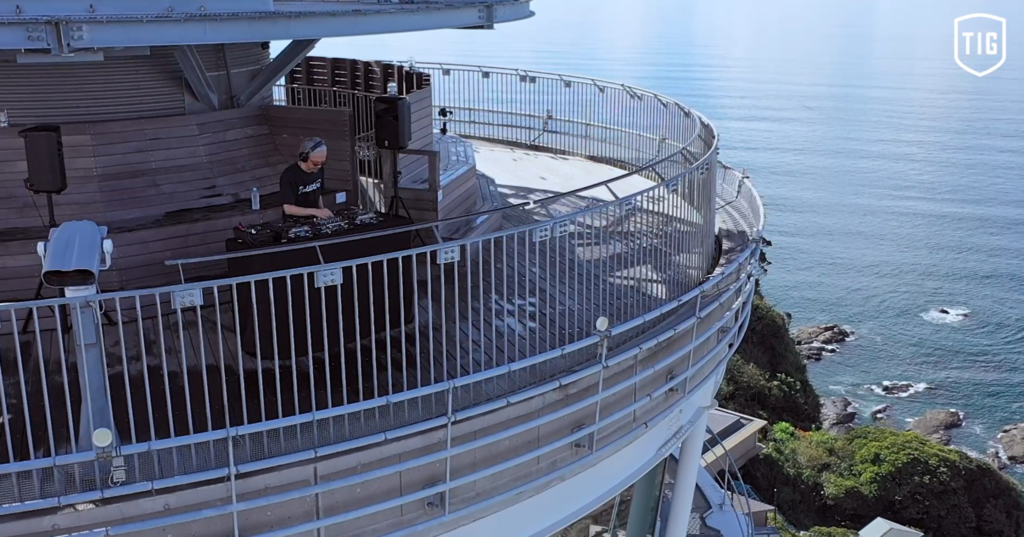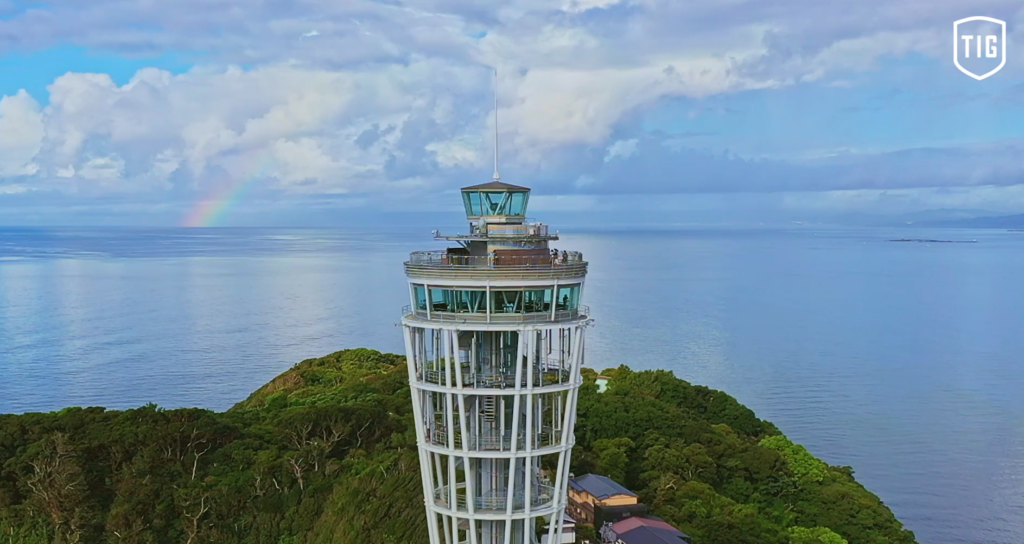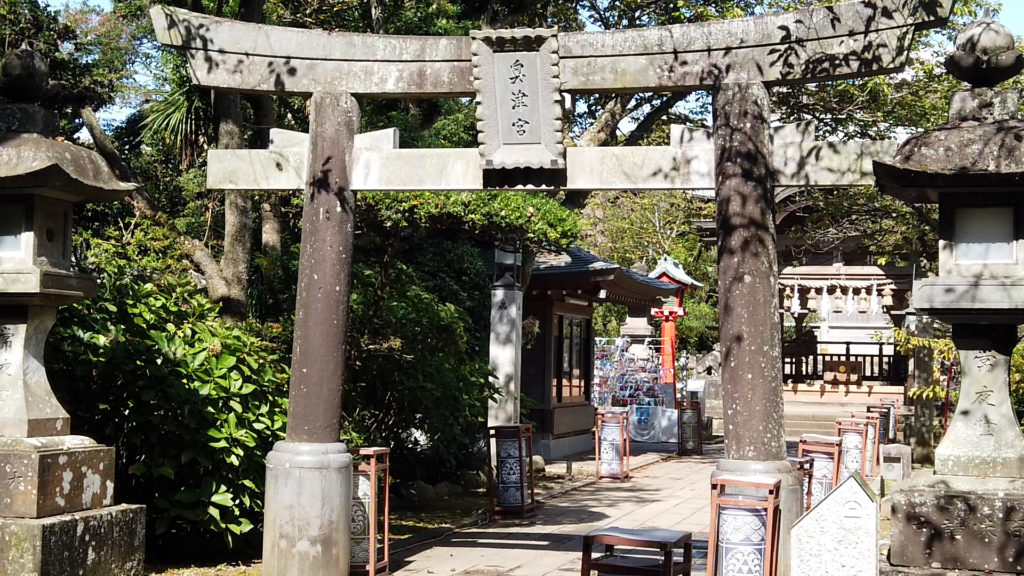- JAPANESE
- LANGUAGE
X
 THAT IS GOOD
THAT IS GOOD

On August 27th, we invited artist Kaoru Inoue to shoot on the top floor deck of the lighthouse “Sea Candle”, which is also a landmark of Enoshima.
When deciding on the performers, I gave some names to Enoshima Electric Railway Co., Ltd., and I received an unspoken offer saying, “Kaoru Inoue has been indebted to us at events for a long time.” Then we consulted with Mr. Yuichiro Shibata called Shiba-san, who has held the event “Freedom Sunset” in which Kaoru Inoue also appeared for many years, and I received Mr.Kaoru Inoue’s consent through management.

Unfortunately it was a rain forecast on that day. Just when the equipment was ready, a rain cloud appeared between Miura Peninsula and Enoshima and headed for us. However, it was a passing shower so that the pillars of rain could be clearly seen under the clouds to the sea, and after just wetting the deck for a while, a few minutes later, a beautiful rainbow appeared on the southwestern sky.
Enoshima is a land-tied island in Fujisawa City, Kanagawa Prefecture, which is connected to the land by the formation of sandbars. Waves coming from offshore wrap around the island and weaken, carrying sand and creating a calm sea.
The island is surrounded by high cliffs carved by waves, and there is also a Iwaya (cave) created by erosion, which has been used as a training ground since ancient times. It is said that historical figures practiced asceticism, for example, in the Asuka period, En no Gyoja, also known as En no Odzunu, in the Heian period, Kukai, Ennin, and in the Kamakura period, Ryoushin (merciful superior) and Ippen. In addition, Minamoto no Yoritomo, who opened Kamakura, dedicated the torii gate(A gateway to a Shinto shrine), and it is said that it was popular and worshiped by successive shoguns and samurai family as a god of victory.
It has been known as a picturesque scenery since ancient times. During the Edo period, there are many shukubo where worshipers can stay and it prospered as a tourist destination for the common people who visited shrines as official stance. After that, in the Meiji era, many foreigners came to visit Enoshima, which is scenic and has accommodation facilities. The Irish trader Samuel Cocking bought a vegetable garden at the temple and built a villa and a garden, which later became a tropical botanical garden, which is the origin of the current “Enoshima Samuel Cocking Garden”.
The main deities of Enoshima Shrine are Tagirihime no Mikoto at Okutsumiya, Ichikishimahime no Mikoto at Nakatsumiya, and Tagituhime no mikoto at Hetsumiya. A god born when Amaterasu Omikami pledged to Susanoo-no-Mikoto, and is the goddess of three sisters, also known as the Munakata Sanjoshin( the Three Goddesses of Munakata). It is considered to be the supreme deity that governs all “roads,” and has long been revered as a god who prays for the safety of voyages.

Due to Shinbutsu Shugo(the fusion of Shinto and Buddhism), Benzaiten became worshiped as one of the guardian deities of Buddhism, but that Benzaiten was originally the Hindu goddess Sarasvati, a god worshiped as a sacred river and its incarnation. Originally a god of water, it was later regarded as a goddess of “knowledge” such as art and scholarship, so Enoshima Benzaiten was also enshrined as a god of art in the latter half of the Edo period. In Japan, by rewriting from “才:Zai(talent)” to “財:Zai(fortune)”, it also has the character of a treasure god.

By the way, it is said to be the god of art and scholarship, but in detail it means the god of music and the god of arts, and I thought that it would be a good match for this shooting, so we visited during the shooting.
It was the first lighthouse installed in 1951 as Japan’s first private lighthouse, but it has become too old since then, during the economic boom of the 1980s and 1990s, Japanese tourist destinations moved from near to far, so it seems that Enoshima tourism was down for a while. In 2002, construction of the current lighthouse “Sea Candle” was started to commemorate the 100th anniversary of the opening of Enoshima Electric Railway, and on December 31, the same year, it was lit for the first time as the finale of the anniversary project.
The observatory for sightseeing opened in April of the following year, and in response to the intention of Enoshima Electric Railway to carry out branding centered on events, “Freedom Sunset(Current「Sunset Lounge」)” was held by Shiba san for the first time, and it will continue for 18 years.
At that time, Mr. Shiba, who was consulted, visited Ibiza Island in Spain shortly before, and was inspired by how the island itself was lively with music. He was wondering if there could be an event involving a similar area in Japan. Therefore, he created a unique world view by incorporating the essence of the Pacific Ocean and Asia, such as Hawaiian and Balinese music.
Furthermore, in the old days, it was a power spot used as a place of training, and in the Edo period, it paid homage to Enoshima, which became a pilgrimage site for the common people as a god of performing arts, and he found significance in holding an event as a “dedication” to God. He took in Awa Odori, Eisa, samba, etc. in “Freedom Sunset” because that made him picture an image of dedication.
The number of Enoshima tourists (visitors to Samuel Cocking Garden) was about 170,000 when the second-generation lighthouse “Sea Candle” opened in 2003, and it reached 500,000 in 2019. Although various other events are being held, it can be said that the achievement of “Freedom Sunset” as a pioneer of music events in Enoshima was very great.
So, we believed that the fact that this shooting was realized by the connection of various people and that even the beautiful rainbow was shown despite the rain forecast may be a proof that the god of Enoshima was pleased. The second THAT IS GOOD “Superb view x DJ Kaoru Inoue | Enoshima” may be beneficial just to watch, so please enjoy it!
Written by THAT IS GOOD editorial department Nakamura